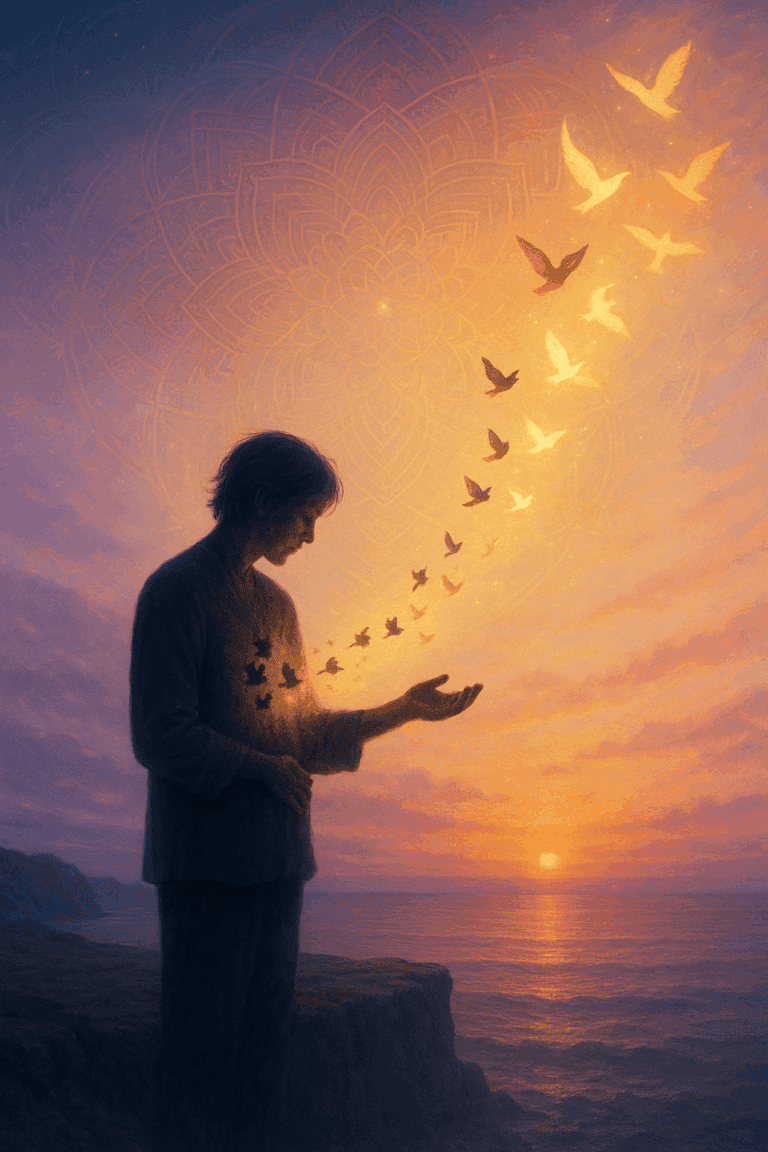The Hero’s Journey Overview
Understanding the Monomyth
The Hero’s Journey, often referred to as the Monomyth, was popularized by Joseph Campbell in his book “The Hero With A Thousand Faces” published in 1949. This narrative framework describes a common heroic arc in which the protagonist embarks on an adventure, undergoes significant transformation, and returns home (Monomyth: Hero’s Journey Project). The Monomyth is universal, appearing across different cultures and time periods, making it a cornerstone for understanding personal development and epic storytelling.
To break it down, the Hero’s Journey consists of three overarching stages:
- Departure: The hero leaves their ordinary world.
- Initiation: The hero undergoes trials and gains critical insights.
- Return: The transformed hero returns home with newfound wisdom.
For a visual representation, you can check out our detailed hero’s journey diagram.

Importance of the Hero’s Journey
Understanding the Hero’s Journey is not just beneficial for appreciating stories and myths; it can also be a powerful tool for personal growth and self-improvement. The Monomyth provides a roadmap for navigating our own life’s challenges, helping us recognize the transformative power of adversity and triumph (Kindlepreneur).
Here’s why the Hero’s Journey is important:
- Self-Reflection: By comparing personal experiences to the stages of the Hero’s Journey, you can gain deeper insight into your own growth. For example, recognizing a pivotal “Call to Adventure” in your life might help you understand significant turning points.
- Empowerment: Knowing that heroes often refuse the call at first, but eventually find the courage to face their trials, can be inspiring. It affirms that initial hesitation doesn’t preclude eventual success.
- Relatability: Stories that follow the Hero’s Journey arc are universally relatable. This makes it easier to connect with literature, film, and folklore.
- Goal Setting: Understanding the stages helps in setting personal goals and identifying the necessary steps to overcome challenges and achieve those goals.
If you want to dive deeper, consider exploring our detailed article on the hero’s journey steps.
In conclusion, the Hero’s Journey offers a framework not only for epic stories but for personal evolution. Whether you’re looking to understand the intricacies of storytelling or seeking guidance in your quest for self-development, the stages of the hero’s journey can be a valuable companion. Looking for real-life inspirations? Check out various hero’s journey examples.
The Stages of Departure
In the Hero’s Journey, the departure stages are fundamental as they set the stage for the hero’s transformation. Here are the key stages of departure that begin the epic journey.
The Ordinary World
The Hero’s Journey typically begins in the ordinary world, where the hero exists in a mundane and familiar setting. In this stage, you are introduced to the hero’s everyday life, their environment, and the people surrounding them. This stage serves to highlight the contrast between the known world and the adventures that lie ahead. For example, consider The Wizard of Oz, where Dorothy starts in Kansas—a representation of her ordinary world.

The Call to Adventure
The Call to Adventure is the invitation for the hero to leave their ordinary world and embark on a journey to partake in new experiences. This can come in many forms, such as a challenge, a quest, or a significant life event. It’s at this point that the hero begins to sense that there is something more to their existence, prompting them to step out of their comfort zone.
| Story | Call to Adventure |
|---|---|
| The Wizard of Oz | Dorothy is transported to Oz by a tornado. |
| Spider-Man | Peter Parker gets bitten by a radioactive spider. |
Refusing the Call
At this stage, the hero may initially hesitate or refuse the call to adventure due to fear, insecurity, or reluctance to leave their familiar world. This refusal emphasizes the hero’s vulnerability and the perceived risks of embarking on the journey.
Many heroes experience a moment of doubt before committing to their journey. For instance, in Marvel’s Spiderman, Peter Parker initially struggles with his new powers and the responsibilities that come with them. Understanding this stage helps us relate to the hero, highlighting their human side.
Explore deeper into the hero’s journey steps to understand how each stage contributes to the overall narrative.
By recognizing these stages, we can better appreciate the transformative power of the Hero’s Journey. Whether you’re a writer crafting your own story or someone navigating your personal voyage, these stages offer valuable insights into growth and self-discovery. For additional insights and examples, visit our detailed hero’s journey diagram and hero’s journey examples.
The Stages of Initiation
The Initiation phase of the Hero’s Journey represents the core of the adventure where challenges and growth occur. During this stage, the hero encounters significant trials and transformative experiences.
Meeting the Mentor
When the hero is on the brink of adventure, a mentor often appears to offer guidance, knowledge, and sometimes magical items to aid in the journey (Kindlepreneur). This mentor figure can be seen in various well-known examples like Dumbledore in “Harry Potter and the Philosopher’s Stone” or Haymitch in “The Hunger Games.”
In our own lives, mentors might appear as teachers, family members, or role models who provide the wisdom or resources necessary for us to succeed.
Crossing the Threshold
Once the hero is equipped with knowledge and tools, they must leave their familiar world and step into the unknown — this is “Crossing the Threshold.” It signifies a commitment to the journey ahead (Monomyth: Hero’s Journey Project). This stage marks a point of no return where the hero fully enters the realm of adventure.
For instance, when Frodo leaves the Shire in “The Lord of the Rings,” he crosses into a world filled with perils and wondrous new experiences.
Tests, Allies, and Enemies
Upon crossing the threshold, the hero encounters several tests and challenges that test their resolve and capability. Along the way, they are also likely to meet allies who will assist, and enemies who will oppose their progress (Novel Software).
In these trials, strength and weaknesses are revealed, not only in the hero but in their supporting cast as well. This is where the real adventure begins, similar to Katniss facing the Capitol’s deadly games or Spider-Man’s confrontations with villains while discovering his powers.
Here’s a quick breakdown of classic stories with respective mentors, thresholds, and tests:
| Story | Mentor | Threshold | Tests, Allies, and Enemies |
|---|---|---|---|
| Harry Potter | Dumbledore | Platform 9¾ | Facing Voldemort, Allies: Ron, Hermione |
| The Hunger Games | Haymitch | Entering the Arena | Surviving the Games, Allies: Peeta |
| The Wizard of Oz | Glinda the Good Witch | Leaving Munchkinland | Wicked Witch of the West, Allies: Lion, Scarecrow, Tin Man |
| Spider-Man | Uncle Ben | Accepting his Spider abilities | Confronting Villains, Allies: Mary Jane, Aunt May |
As personal development enthusiasts, understanding these stages helps us map our own life journeys. Whether seeking hero’s journey examples or visualizing our path through a hero’s journey diagram, recognizing these patterns encourages growth and transformation.
The Stages of Return
Embarking on the adventure is just the beginning. The return phase of the hero’s journey marks the final leg, encompassing critical moments that lead to the hero’s transformation. This phase includes three pivotal stages: the Approach to the Inmost Cave, the Ordeal, and the Reward.
Approach to the Inmost Cave
In the “Approach to the Inmost Cave,” I find myself at the threshold of the most challenging part of my journey. This is the period where I must face my deepest fears and confront the trials I’ve been avoiding. It often feels like the darkest moment before dawn, akin to the tense build-up in the narrative of many classic tales.
Consider the example of Psyche from the myth of Cupid and Psyche (Wikipedia). Her approach involved stepping into a series of seemingly insurmountable tasks set by Venus, propelling her towards enlightenment and immortal status.
The Ordeal
The Ordeal is the stage where I face my ultimate test. It’s the climactic event where everything hangs in the balance. At this juncture, I may encounter a tremendous challenge, often referred to as a “final battle” or a critical showdown (Monomyth: Hero’s Journey Project). Overcoming this ordeal signifies a pivotal shift, leading to the hero’s rebirth and deeper transformation.
A compelling illustration of this is Jane Eyre’s confrontation with Mr. Rochester and her own emotions in Charlotte Brontë’s novel (Wikipedia). It is through this intense personal ordeal that Jane realizes her own worth and emerges empowered.
| Key Elements | Description |
|---|---|
| Challenge Type | Final battle or ultimate challenge |
| Emotional Impact | High, often life or death stakes |
| Transformation | Hero gains new insights or powers |
The Reward
Following the Ordeal comes the Reward, also known as the “Seizing the Sword” in some versions of the hero’s journey. This stage signifies my triumph and the acquisition of something beneficial. Whether it’s a physical object, knowledge, or a regained sense of purpose, this reward marks the culmination of my efforts.
In “Aladdin,” for example, the titular character gains not just treasure but also self-realization and acceptance (TEDxMileHigh). This reward sets the stage for the eventual return home, bearing the gifts and wisdom attained through the journey.
To delve deeper into classic examples of the hero’s journey, I can explore diverse narratives such as “Avatar” and “To Kill A Mockingbird” (TEDxMileHigh). Their stories illustrate how different characters navigate these transformative stages, ultimately leading to a deeper understanding of themselves and their world.
For a visual representation of the stages, refer to our hero’s journey diagram. Examining these different aspects can enrich my comprehension of my own personal growth journey, ensuring I navigate each phase with insight and clarity.
The Hero’s Transformation
The final phase of the hero’s journey is the transformation, a stage where the hero not only returns to the ordinary world but also embodies lasting changes. This stage includes pivotal steps such as “The Road Back,” “Resurrection,” and “Return With the Elixir.”
The Road Back
After triumphing in their quest, the hero begins their journey back home. This step, referred to as “The Road Back,” is not without its challenges. The hero may face external or internal obstacles that test their resolve to bring back the newfound wisdom or reward. This stage signifies the hero’s commitment to return and integrate the changes they’ve undergone during their adventure.
For personal development enthusiasts, “The Road Back” can be seen as the point where you start to apply the lessons learned during your journey to real-life situations. The path may not be straightforward, but it’s essential for solidifying your transformation. Check out more about the hero’s journey steps for a deeper understanding.
Resurrection
The “Resurrection” stage serves as the ultimate test of the hero’s newly acquired skills and wisdom. Often symbolized by a near-death experience or a climactic final battle, this stage serves to purify and validate the hero’s transformation. The hero emerges from this trial not just victorious but fundamentally changed.
In personal development terms, “Resurrection” could be analogous to a significant challenge or turning point in your life where you demonstrate your newfound abilities and knowledge. It’s a moment of reckoning where you prove to yourself and others that you have truly evolved.
Return With the Elixir
Finally, the hero returns to the ordinary world bringing with them the “Elixir”—a symbol of the wisdom, knowledge, or reward gained from the journey. This elixir benefits not just the hero but also the society they return to, impacting their personal life and the wider community in positive ways (Scott Jeffrey).
In your personal journey, this elixir could be anything from new insights, skills, a transformed mindset, or tangible rewards. The key is that the hero shares what they’ve gained, enhancing their own life and contributing to others’ growth as well.
For more examples illustrating this part of the hero’s journey, look at our hero’s journey examples, and you’ll find how timeless and universal this pattern truly is.
Here’s a brief summary table of these transformation stages:
| Stage | Description |
|---|---|
| The Road Back | The hero begins the journey back, facing final challenges and committing to return. |
| Resurrection | The hero undergoes a final test, symbolizing a significant transformation. |
| Return With the Elixir | The hero brings back and shares the knowledge or reward gained from the journey. |
Each of these stages plays a vital role in completing the hero’s journey, transforming them from an ordinary individual into a figure of wisdom and strength. For further insights into the intricacies of the hero’s journey, including the archetypes and diagrammatic representations of these stages, visit our pages on the hero’s journey archetype and the hero’s journey diagram.






2 Comments
Comments are closed.